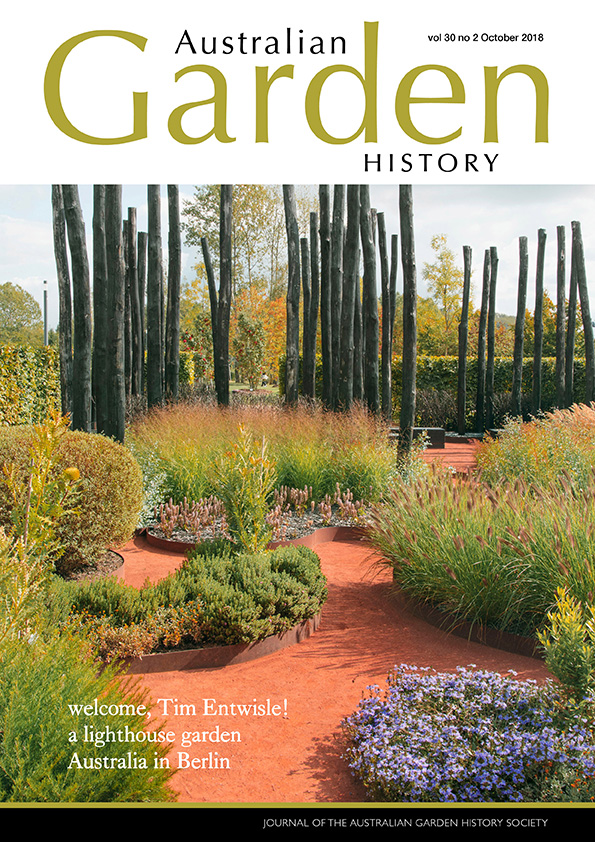Contents
Snippets: Managing honour avenues
One enduring reminder of our role in the Great War is the avenues of honour in the landscape today. With ageing trees, communities are facing decisions on the future of avenues of honour.
Breadfruit, Bligh and a blinder of a museum Richard Heathcote
In Britain, flower shows and botanic gardens remain popular whatever their scale, and reflect the public’s passion and interest in plants new and old. This can be seen at the Garden Museum, the works of John Tradescant (ca 1580-1638) and Bligh’s tomb.
Piglets and pelargoniums Julie Tolley
Families who lived at lighthouses, particularly those on islands, could not rely solely on regular supplies of food and goods, and gardens were established which supplemented their diet. There is evidence that at Cape Willoughby on South Australia’s Kangaroo Island, gardens were created and maintained from the 1850s for over a century, and fruit and vegetables were cultivated. Flowers were also grown which provided a contrast to the harsh and often hostile environment, by creating a calm and harmonious sense of familiar domesticity.
Close to nature: May Gibbs and Australian botanical artists Anna Jug
In the 18th and 19th centuries a genuine appreciation of the unique Australian bush emerged, and with it a desire in some to protect and preserve the unique flora and fauna that was rapidly disappearing around expanding settlements. Among the early bush conservationists were
women – such as Fanny de Mole, Marian Ellis Rowan and Rosa Fiveash – who collected and drew plant specimens for botanists such as Ferdinand von Mueller. The work of May Gibbs offered a precedent for bringing Australian flora and fauna to life in a new visual style
An Australian garden in Berlin Dianne Firth
In 2017, the International Horticultural Exhibition was held in Berlin, on the theme ‘An Ocean of Colours’. The garden Cultivated by Fire by landscape architecture firm Taylor Cullity Lethlean was Australia’s contribution to the 2017 exhibition. Cultivated by Fire is now part of the permanent collection of Gardens of the World, located in Marzhan-Hellersdorf in Berlin.
A formal French garden on a South Atlantic island Tim Gatehouse
It comes as a surprise to find a formal French garden on an island in the South Atlantic Ocean, but such a garden surrounds Longwood House, Napoleon Bonaparte’s residence in exile on the remote South Atlantic island of St Helena. He lived here from 1815 until his death in May 1821, although the garden was only created in the last two years of his life.
The garden at Riversdale, Goulburn Ros Loftus
Riversdale in Goulburn, NSW, is a state heritage-listed group of early colonial buildings around the original homestead. Riversdale also has historic and aesthetic significance for its partly intact early colonial garden, which has survived periods of significant neglect and recent very severe drought. The garden today is a cornucopia of rich plantings, sweeping lawns, secret places, surprises, secluded pathways and living echoes of the past.
Identifying plants in old photographs and paintings Sandra Pullman
A painting by William Thomas Lewis of 42A Bayview Crescent, Black Rock (the author’s childhood home) led to a desire by the author to uncover the painting’s history and the plants found in the garden. This involved many different sources.
Victoria’s National Trust gardens Anne Vale
Australia’s garden history has been recounted in many ways – through the achievements of influential people, the history of significant elements, and the focus on particular eras. Gardens of the National Trust of Australia (Victoria) takes the reader on a tour of Australia’s garden history through the lens of an organisation dedicated to saving and showcasing a diversity of gardens throughout Victoria.
A personal look at The Language of Flowers Chris Betteridge
The Language of Flowers is a first novel by American author Vanessa Diffenbaugh. After reading the book you may view your garden very differently.
Getting to know them
In this extract from The AGHS’s oral history collection, Phyl Simons discusses her early gardening influences.


